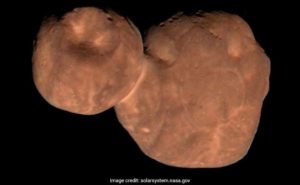NASA: finds Evidence of Water on Ultima Thule
(486958) 2014 MU69, also known as Ultima Thule, is a small, distant celestial object located in the Kuiper Belt, a region of the solar system beyond Neptune that is home to many small, icy objects. Ultima Thule was discovered in 2014 by the New Horizons spacecraft and was visited by the spacecraft on January 1, 2019. It is believed to be a remnant of the early solar system and is thought to be composed of ices and rock. Ultima Thule is the most distant object ever visited by a spacecraft and is providing scientists with valuable insights into the early history of the solar system.
About Ultima Thule
- Nomenclature: Its scientific name is (486958) 2014 MU69. The words ‘Ultima’ and ‘Thule’ is its nickname. Ultima Thule, is a Greco-Latin term which means a distant unknown world.
- About: It is a trans-Neptunian object located in Kuiper belt (a circumstellar disc in outer Solar System). It is the farthest world ever explored by mankind. The flyby (close enough to record scientific data) of Ultima Thule is farthest exploration of an object till date. It is approximately 6.4 billion km from Earth.
- Discovery: It was discovered in 2014 by astronomers using Hubble Space Telescope as part of their search for a Kuiper belt object for New Horizons mission (which was an interplanetary space probe launched by NASA). On 1 January 2019 NASA’s New Horizons space probe’s flyby Ultima Thule making it the farthest object in Solar System visited by a spacecraft.
- Significance: The discoveries made about Ultima Thule are going to advance theories of solar system formation.
Key Features
- Recently, NASA published first profile of Ultima Thule which reveals details about complex space object.
- Shape: The object is a contact binary, with two distinguishable differently shaped lobes. About 36 km long ‘Ultima Thule’ consists of a large (19 km), strangely flat lobe (Nicknamed Ultima) which is connected to a smaller (14 km), somewhat rounder lobe (nicknamed Thule), at a juncture which is called “the neck.” Both bodies seem to be planetesimal aggregates of much smaller building blocks, thus indicate that it could be most primitive object in Solar System.
- The alignment of axes of Ultima and Thule suggests that before merger two lobes must have become tidally locked, which means that same sides must have always faced each other as they orbited around same point.
- The largest depression found in Ultima Thule is about 8 km wide feature which is nicknamed as ‘Maryland crater’, is likely formed from an impact.
- It has an orbital period of about 298 years and a low inclination and eccentricity.
- Colour: In colour and composition, Ultima Thule resembles many other objects found in its area of Kuiper Belt. It is very red even redder even than Pluto (2,400-km wide). The reason for its reddish hue is believed to be the modification of organic materials on its surface.
Month: Current Affairs - May, 2019


